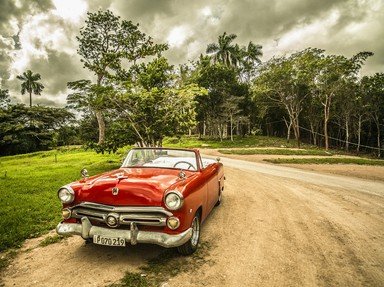Quiz Answer Key and Fun Facts
1. What was the name of the too-far-ahead-of-its-time car that Preston Tucker tried to bring to market?
2. What is the domestic, Japanese name of the fabled Nissan "Z" car?
3. What is the full name of the man who gave his surname to the late, lamented Oldsmobile?
4. Hugh Hefner would have loved this car, produced by the Jordan Motor Car Company in the early 20s. What was the name of this spiffy machine, somewhere west of Laramie...?
5. In 2005, after years of development, Volkswagen re-introduced a venerable old name into the automotive spotlight again. This legendary name hadn't been on anything respectable for 70 years! Can you guess the name of this venerated old marque, whose name is slapped on a truly fantastic automobile that has, quite simply, no equal anywhere in the auto world?
6. Between 1969 and 2015, which much larger company owned Ferrari?
7. What type of engine powers all Subaru cars?
8. What year did the Chevrolet Corvette go all-disc brake?
9. Can you name all four "senior compacts" on the GM roster from the early 1960s?
10. Which car company is guilty of popularizing front wheel drive in the U.S. automotive industry, to the point where it was adapted by just about everybody?
11. Whoops, what do you know! There was a German brand that failed in the American marketplace, perhaps because they had one of the _ugliest_ lines of cars ever designed. What was this Deutsche brand?
12. For years, Pontiac has been famous for its "split grille" styling theme. What year did this theme get started?
13. What was odd about the engine of Saab's egg-shaped VW Bug fighter of the 1950s and 60s?
14. Would you believe that Spain actually produced a high-priced GT automobile? Well, it did! What was its name?
15. Name all five divisions of BMC.
16. Of the US big three, who was first to produce a retractable hardtop vehicle?
17. Where is legendary race car driver Jacky Ickx from?
18. What US domestic marque's engine did Briggs Cunningham put in his first racing and homologated GT car for Le Mans?
19. In 1960, all three members of the US big three simultaneously introduced compact models. Can you name all three, division and model?
20. Can you name all the mid-sixties, intermediate-based muscle cars inspired by the Pontiac GTO?
Source: Author
photoscribe
This quiz was reviewed by FunTrivia editor
Bruyere before going online.
Any errors found in FunTrivia content are routinely corrected through our feedback system.
